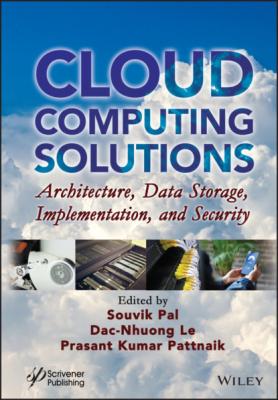Cloud Computing Solutions. Группа авторов
Читать онлайн.| Название | Cloud Computing Solutions |
|---|---|
| Автор произведения | Группа авторов |
| Жанр | Базы данных |
| Серия | |
| Издательство | Базы данных |
| Год выпуска | 0 |
| isbn | 9781119682028 |
Directory services: Enables its clients to ask questions for artifacts by type, accessibility or load-sharing demand. Resource-level protocol is utilized in building indexes.
Scheduling, co-allocation and brokering service: This service enables members to ask for distribution of assignments of at least one physical resource for a specific reason and the scheduling of undertakings for appropriate resources.
Monitoring and diagnostic services: These specific applications screen asset designation, overload management, and additionally keep considerations regarding the assaults.
Data replication services: It supports the capacity management to expand the data received to execute and limit the reaction time and money.
Workload management systems: These systems deal with the utilization, depiction, status of the errand and multi-component work processes.
1.3.3.5 Application Layer
The end layer of grid framework is the application layer which interacts with the end users. According to the user applications, physical resources are provisioned and properly used by the applications.
Scientific and engineering: In the scientific and engineering fields, various application specific and user-specific requirements are entertained and physical and computing resources are provisioned accordingly.
Problem-solving statement: Application layer directly interacts with the problem-solving area. Application layer solves the problem module-wise.
Web-based apps: Application layer handles the Web-based apps and provides access to services like resource management, data access and so forth.
1.3.3.6 Comparison-Based Study of Cluster, Grid and Cloud Computing
Table 1.1 below describes a comparison-based study of cluster, grid and cloud.
Table 1.1: A comparison-based study of cluster, grid and cloud.
| Characteristic | Clusters | Grids | Clouds |
| Allocation | Centralized | Decentralized | Both |
| Resource Handling | Centralized | Distributed | Both |
| Computation Service | Computing | Maximum computing | On-demand |
| Scalability | No | Partial scalable | Full scalable |
| Virtualization | Partial | Partial | Full |
| Business Model | No | No | Yes |
1.4 Mobile Computing
Two major developments over the last decade have revolutionized the way people use their computers. First, advances in the miniaturization of circuits and components have made it possible to pack powerful processing units into portable laptops and more recently in palmtop computers. As a result, people from all walks of life have started carrying personal computers wherever they go. The second major development concerns computer communication and wireless networking of portable computers becoming a reality. These two developments have merged portable personal computing and communication to form the discipline of mobile computing [19-25].
Figure 1.7: Mobile computing.
Mobile computing is widely described as the ability to compute and communicate while on the move. This new emerging discipline has made it possible for people to get information from anywhere and at any time. Mobile computing means two separate and distinct concepts: mobility and computing. Computing denotes the capability to automatically carry out certain processing. Mobility, on the other hand, provides the capability to change a portable location during communication and computing. The main advantage of this mobility is the flexibility that it provides to the user. The user need not necessarily sit in front of his desktop, but can either move locally or even to faraway places.
1.4.1 Characteristics of Mobile Computing
A computing environment is said to be “mobile” when either the sender or receiver of information can move (mobile) while transmitting or receiving information. The following are the important characteristics of a mobile computing environment.
Ubiquity: The definition of ubiquity is “the state of being everywhere all the time.” Mobile computing allows a user to perform computation from anywhere, anytime. For example, a business executive can receive business notifications and issue business transactions as long he/she is in wireless coverage area.
Location awareness: A handheld device equipped with a global positioning system (GPS) can provide information about the current location of a user. Many applications ranging from strategic to personalized services require or get value additions with location-based services. For example, while a person is on the move, he/she may be on the lookout for car maintenance services available nearby. This can be very easily achieved through mobile computing. Of the numerous applications, a few example applications are traffic control, fleet management and emergency and security services.
Adaptation: Adaptation implies the ability of a system to adjust to bandwidth fluctuation without inconveniencing the user. In a mobile environment, adaptation is crucial because of intermittent disconnections and bandwidth fluctuations that arise due to handoff, obstacles, environmental noise, etc.
Broadcasting: Efficient delivery of data to hundreds of mobile users simultaneously is possible in the mobile environment due to the fundamental broadcast nature of the underlying communication.
Personalization: Services in the mobile environment can be tailored to the user’s profile. This is required to let users easily avail information with handheld devices. For example, a mobile user may need certain information from specific sources, which can be easily achieved through personalization.
1.4.2 Characteristics of Mobile Networks
A few important characteristics of a mobile network are the following:
Dynamic topologies: Since systems can be moved subjectively, the system topology may change capriciously.
